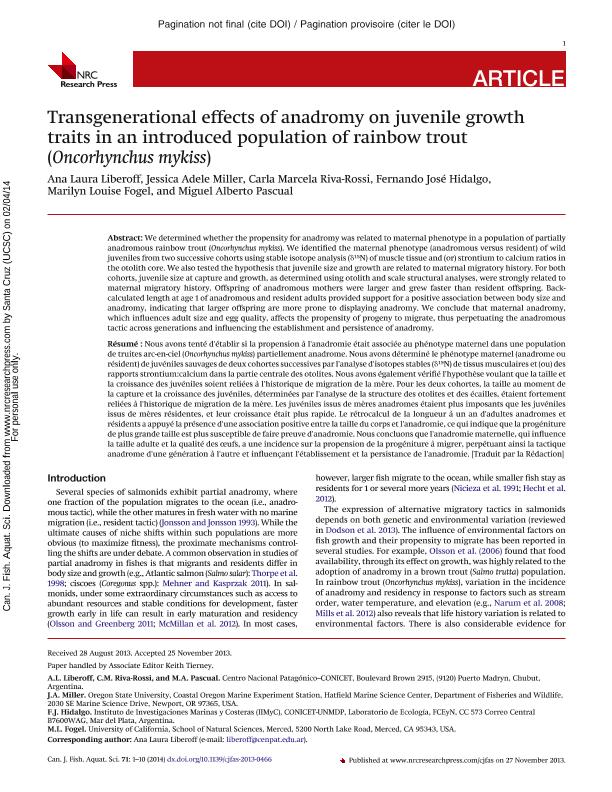Mostrar el registro sencillo del ítem
dc.contributor.author
Liberoff, Ana Laura

dc.contributor.author
Miller, Jessica Adele
dc.contributor.author
Riva Rossi, Carla Marcela

dc.contributor.author
Hidalgo, Fernando José
dc.contributor.author
Fogel, Marilyn Loise
dc.contributor.author
Pascual, Miguel Alberto

dc.date.available
2017-06-01T14:21:41Z
dc.date.issued
2013-11-27
dc.identifier.citation
Liberoff, Ana Laura; Miller, Jessica Adele; Riva Rossi, Carla Marcela; Hidalgo, Fernando José; Fogel, Marilyn Loise; et al.; Transgenerational effects of anadromy on juvenile growth traits in an introduced population of rainbow trout (Oncorhynchus mykiss); Natl Research Council Canada-n R C Research Press; Canadian Journal Of Fisheries And Aquatic Sciences; 71; 3; 27-11-2013; 398-407
dc.identifier.issn
0706-652X
dc.identifier.uri
http://hdl.handle.net/11336/17270
dc.description.abstract
We determined whether the propensity for anadromy was related to maternal phenotype in a population of partially anadromous rainbow trout (Oncorhynchus mykiss). We identified the maternal phenotype (anadromous versus resident) of wild juveniles from two successive cohorts using stable isotope analysis (δ15N) of muscle tissue and (or) strontium to calcium ratios in the otolith core. We also tested the hypothesis that juvenile size and growth are related to maternal migratory history. For both cohorts, juvenile size at capture and growth, as determined using otolith and scale structural analyses, were strongly related to maternal migratory history. Offspring of anadromous mothers were larger and grew faster than resident offspring. Back-calculated length at age 1 of anadromous and resident adults provided support for a positive association between body size and anadromy, indicating that larger offspring are more prone to displaying anadromy. We conclude that maternal anadromy, which influences adult size and egg quality, affects the propensity of progeny to migrate, thus perpetuating the anadromous tactic across generations and influencing the establishment and persistence of anadromy.
dc.description.abstract
Nous avons tenté d'établir si la propension à l'anadromie était associée au phénotype maternel dans une population de truites arc-en-ciel (Oncorhynchus mykiss) partiellement anadrome. Nous avons déterminé le phénotype maternel (anadrome ou résident) de juvéniles sauvages de deux cohortes successives par l'analyse d'isotopes stables (δ15N) de tissus musculaires et (ou) des rapports strontium:calcium dans la partie centrale des otolites. Nous avons également vérifié l'hypothèse voulant que la taille et la croissance des juvéniles soient reliées à l'historique de migration de la mère. Pour les deux cohortes, la taille au moment de la capture et la croissance des juvéniles, déterminées par l'analyse de la structure des otolites et des écailles, étaient fortement reliées à l'historique de migration de la mère. Les juvéniles issus de mères anadromes étaient plus imposants que les juvéniles issus de mères résidentes, et leur croissance était plus rapide. Le rétrocalcul de la longueur à un an d'adultes anadromes et résidents a appuyé la présence d'une association positive entre la taille du corps et l'anadromie, ce qui indique que la progéniture de plus grande taille est plus susceptible de faire preuve d'anadromie. Nous concluons que l'anadromie maternelle, qui influence la taille adulte et la qualité des œufs, a une incidence sur la propension de la progéniture à migrer, perpétuant ainsi la tactique anadrome d'une génération à l'autre et influençant l'établissement et la persistance de l'anadromie.
dc.format
application/pdf
dc.language.iso
eng
dc.publisher
Natl Research Council Canada-n R C Research Press

dc.rights
info:eu-repo/semantics/openAccess
dc.rights.uri
https://creativecommons.org/licenses/by-nc-sa/2.5/ar/
dc.subject
Maternal Effects
dc.subject
Anadromy
dc.subject
Growth
dc.subject
Salmonids
dc.subject.classification
Ecología

dc.subject.classification
Ciencias Biológicas

dc.subject.classification
CIENCIAS NATURALES Y EXACTAS

dc.title
Transgenerational effects of anadromy on juvenile growth traits in an introduced population of rainbow trout (Oncorhynchus mykiss)
dc.type
info:eu-repo/semantics/article
dc.type
info:ar-repo/semantics/artículo
dc.type
info:eu-repo/semantics/publishedVersion
dc.date.updated
2017-05-29T15:46:37Z
dc.journal.volume
71
dc.journal.number
3
dc.journal.pagination
398-407
dc.journal.pais
Canadá

dc.journal.ciudad
Otawa
dc.description.fil
Fil: Liberoff, Ana Laura. Consejo Nacional de Investigaciones Científicas y Técnicas. Centro Científico Tecnológico Conicet - Centro Nacional Patagónico; Argentina
dc.description.fil
Fil: Miller, Jessica Adele. State University of Oregon; Estados Unidos
dc.description.fil
Fil: Riva Rossi, Carla Marcela. Consejo Nacional de Investigaciones Científicas y Técnicas. Centro Científico Tecnológico Conicet - Centro Nacional Patagónico; Argentina
dc.description.fil
Fil: Hidalgo, Fernando José. Universidad Nacional de Mar del Plata. Instituto de Investigaciones Marinas y Costeras. Laboratorio de Ecología; Argentina
dc.description.fil
Fil: Fogel, Marilyn Loise. University of California; Estados Unidos
dc.description.fil
Fil: Pascual, Miguel Alberto. Consejo Nacional de Investigaciones Científicas y Técnicas. Centro Científico Tecnológico Conicet - Centro Nacional Patagónico; Argentina
dc.journal.title
Canadian Journal Of Fisheries And Aquatic Sciences
dc.relation.alternativeid
info:eu-repo/semantics/altIdentifier/doi/http://dx.doi.org/10.1139/cjfas-2013-0466
dc.relation.alternativeid
info:eu-repo/semantics/altIdentifier/url/http://www.nrcresearchpress.com/doi/abs/10.1139/cjfas-2013-0466#.WTAi4Pk1-JA
Archivos asociados
